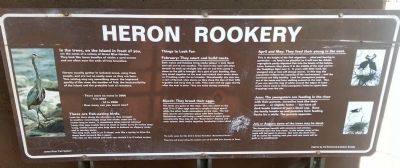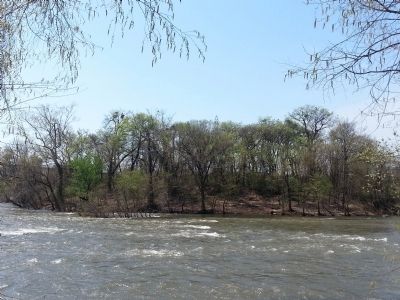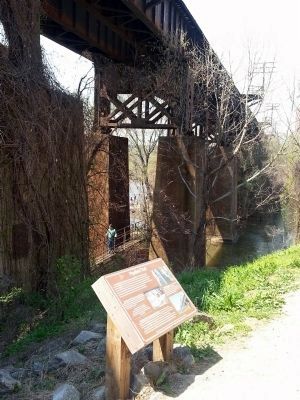Shockoe Slip in Richmond, Virginia — The American South (Mid-Atlantic)
Heron Rookery
In the trees, on the island in front of you, are the nests of a colony of Great Blue Herons. They look like loose bundles of sticks a yard across and are often near the ends of tree branches.
Herons usually gather in isolated areas away from people, and are not so easily seen as they are here. This setting may say something about the improved quality of the river, the number of fish, the inaccessibility of the island and the probable lack of raccoons.
• There were no nests in 2006
• 4 in 2007
• 34 in 2008
• How many can you count now?
These are fish-eating birds.
Look for them along the shoreline as they struggle to swallow surprisingly large fish whole, some are 12 inches long or more. It sometimes takes several minutes!
• Long, thin legs enable them to wade in water up to 24 inches deep
• Long, widely spaced toes help them to balance on slippery rocks and in moving water.
• The long neck, held in an S shape, acts like a spring to drive the sharp beak forward like a spear.
• The skin on the mouth and neck can stretch 4 or 5 inches across.
Things to Look For:
February: They court and build nests.
Both males and females bring sticks (about ½ inch thick) and call out to one another. The bird in the nest will often stretch its neck up straight into the air and then pump it down as the gift is brought. As a part of pair bonding, they may stand together on the nest and stretch their necks down as if looking under for an intruder. Occasionally, you may see a sort of lip-lock slow dance as they clasp the tips of their bills together and sway side to side. They mate nad lay eggs shortly after the nest is done. They are noisy during courtship.
March: They brood their eggs:
The birds are quiet at this time. One sits alone on the nest (3 to 5 blue eggs spaced a couple of days apart) while the other feeds somewhere on the river. The fed bird returns and switches place with little fanfare. Sometimes one will bring a small branch or some grass: occasionally they may do the “head down” display and even scissor their necks together. Incubation takes about a month.
April and May: They feed their young in the nest.
This is the height of the fish migration --- shad and herring in particular --- so food is as plentiful as will ever be. Adults regurgitate partly digested fish into the beaks of the babies. Later, however, they place it in the middle of the nest and let the fledglings fight over it. In years with little food, the youngest one or two will always starve. In this way, the population reflects the capacity of the environment --- and the survivors are fully healthy. Look for youngsters peering out of the nests as later walking around on the nest. See if you can spot the ring of white around the edges of some nest where weak or timid youngsters failed to squirt their droppings over the rim.
June: The youngsters are feeding in the river
with their parents. Juveniles look like their parents – or slightly fatter --- but have all dark heads instead of just a black cap. Soon the family breaks up and juveniles form feeding flocks for a while. The parents separate.
July or August: some of the trees may be dead.
The droppings, caustic with ammonia and nitrates, sometimes burn the tree roots. In the winter, many of the nests will fall apart in storms. But even the dead trees will be useful for nesting next year and new nests will be built or re-conditioned.
The Latin name for this bird is Ardea Herodias: “Arrowhead Heron”. They live and breed along the eastern part of the USA from Canada to Texas.
Paid for by the Richmond Audubon Society
Erected by James River Park System.
Topics. This historical marker is listed in these topic lists: Animals • Environment. A significant historical year for this entry is 2006.
Location. 37° 31.956′ N, 77° 26.121′ W. Marker is in Richmond, Virginia. It is in Shockoe Slip. Marker can be reached from the intersection of East Byrd Street and Virginia Street, on the right when traveling east. Touch for map. Marker is in this post office area: Richmond VA 23219, United States of America. Touch for directions.
Other nearby markers. At least 8 other markers are within walking distance of this marker. Ross' Mill Race (about 300 feet away, measured in a direct line); Tidewater Lock View (about 300 feet away); Pipeline Trail (about 400 feet away); Tidewater Connection Locks (about 400 feet away); A Bateau Pole (about 400 feet away); 13th Street Bridge (about 400 feet away); The Center of Industry in 18th and 19th Century Richmond (about 400 feet away); Gallego Mill Flume (about 500 feet away). Touch for a list and map of all markers in Richmond.
Also see . . .
1. Heron. Wikipedia entry (Submitted on September 23, 2022, by Larry Gertner of New York, New York.)
2. James River Park System. Friends of the James River Park website homepage (Submitted on May 23, 2014.)
Credits. This page was last revised on February 1, 2023. It was originally submitted on May 23, 2014, by Bernard Fisher of Richmond, Virginia. This page has been viewed 760 times since then and 63 times this year. Photos: 1, 2, 3. submitted on May 23, 2014, by Bernard Fisher of Richmond, Virginia.


